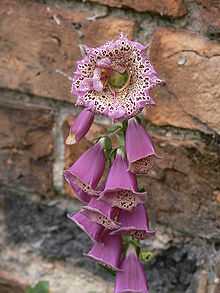Floral symmetry

Floral symmetry describes whether, and how, a flower, in particular its perianth, can be divided into two or more identical or mirror-image parts.
Actinomorphic

Most flowers are actinomorphic ("star shaped", "radial"), meaning they can be divided into 3 or more identical sectors which are related to each other by rotation about the centre of the flower. Typically, each sector might contain one tepal or one petal and one sepal and so on. It may or may not be possible to divide the flower into symmetrical halves by the same number of longitudinal planes passing through the axis: Oleander is an example of a flower without such mirror planes. Actinomorphic flowers are also called radially symmetrical or regular flowers. Other examples of actinomorphic flowers are the lily (Lilium, Liliaceae) and the buttercup (Ranunculus, Ranunculaceae).
Zygomorphic

Zygomorphic ("yoke shaped", "bilateral" - from the Greek ζυγόν, zygon, yoke, and μορφή, morphe, shape) flowers can be divided by only a single plane into two mirror-image halves, much like a yoke or a person's face. Examples are orchids and the flowers of most members of the Lamiales (e.g., Scrophulariaceae and Gesneriaceae). Zygomorphic flowers generally have petals of two more different shapes, sizes, and colors.
Least commonly, flowers may have no axis of symmetry at all, typically because their parts are spirally arranged.
Differences
Actinomorphic flowers are a basal angiosperm character; zygomorphic flowers are a derived character that has evolved many times.[1]
Some familiar and seemingly actinomorphic so-called flowers, such as those of daisies and dandelions (Asteraceae), and most species of Protea, are actually clusters of tiny (not necessarily actinomorphic) flowers arranged into a roughly radially symmetric inflorescence of the form known as a head, capitulum, or pseudanthium.
Peloria

Peloria or a peloric flower refers to an aberration in which a plant that normally produces zygomorphic flowers produces actinomorphic flowers instead. This aberration can be developmental, or it can have a genetic basis: the CYCLOIDEA gene controls floral symmetry. Peloric Antirrhinum plants have been produced by knocking out this gene.[1] Many modern cultivars of Sinningia speciosa ("gloxinia") have been bred to have peloric flowers as they are larger and showier than the normally zygomorphic flowers of this species.
Charles Darwin explored peloria in Antirrhinum (snapdragon) while researching the inheritance of floral characteristics for his The Variation of Animals and Plants under Domestication.[2] Later research, using Digitalis purpurea, showed that his results[3] were largely in line with Mendelian theory.[4]
See also
References
Bibliography
- Endress PK (February 2001). "Evolution of floral symmetry". Curr. Opin. Plant Biol. 4 (1): 86–91. doi:10.1016/S1369-5266(00)00140-0. PMID 11163173.
- Neal P.R., Dafni A., Giurfa M. (1998). "Floral symmetry and its role in plant-pollinator systems: terminology, distribution, and hypotheses". Annu Rev Ecol Syst 29: 345–373. JSTOR 221712.
- Darwin, Charles (1868). The variation of animals and plants under domestication II. London: John Murray.